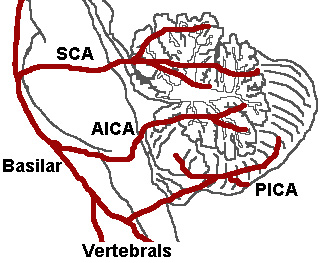Lateral medullary syndrome: Difference between revisions
Jump to navigation
Jump to search
No edit summary |
(→Causes) |
||
| Line 38: | Line 38: | ||
* Dissection | * Dissection | ||
* Dolichoectasia | * Dolichoectasia | ||
* | |||
<br /> | <br /> | ||
Revision as of 19:58, 28 July 2020
| Lateral medullary syndrome | |
 | |
|---|---|
| The three major arteries of the cerebellum: the SCA, AICA, and PICA. (Posterior inferior cerebellar artery is PICA.) | |
| ICD-10 | G46.3 |
| DiseasesDB | 10449 |
| MeSH | D014854 |
Editor-In-Chief: C. Michael Gibson, M.S., M.D. [1]
Synonyms and keywords: Wallenberg's syndrome; posterior inferior cerebellar artery syndrome (PICA)
Overview
Historical Perspective
Pathophysiology
Lateral medullary syndrome is basically a manifestation of vasoocclusive disease of intracranial vertebral artery (ICVA). The various pathophysiologic mechanisms involved can include atherosclerosis, athero-embolic phenomenon (heart, aorta, or vertebral arteries), dissection and increased vascular tortuosity. Involvement of various structures in lateral medulla along with respective manifestation or clinical signs include;
- Nucleus ambiguus: dysphagia, dysphonia and dysarthria, laryngeal, pharyngeal and palatal paralysis
- Trigeminal nucleus: ipsilateral facial and corneal anesthesia
- Spinothalamic tract: loss of pain and temperature sensation to the opposite side of body
- Crebellum: ataxia
- Hypothalamic fibers: sympathetic nervous system abnormal c/w Horners syndrome
- Deiters' nucleus and other vestibular nuclei: nystagmus and vertigo
- Central tegmental tract: palatal myoclonus
Causes
- Atherosclerosis
- Embolism
- Dissection
- Dolichoectasia
Natural History, Complications and Prognosis
Diagnosis
Symptoms
Symptoms include:
- Ageusia or loss of taste on one side of the tongue
- Ataxia or incoordination
- Diplopia or double vision
- Oscillopsia
- Dizziness
- Dysphagia or difficulties with swallowing
- Dysphonia or hoarseness
- Dysarthria or slurred speech
- Facial pain
- Falling
- Palatal myoclonus
- Hiccups
- Hoarseness
- Impaired gait
- Impaired coordination
- Bilateral leg weakness
- Hemiparesis
- Numbness
- Hypesthesia or lack of pain and temperature sensation on only one side of the face
- Nystagmus or rapid involuntary movements of the eyes
- Nausea and vomiting
- Vertigo
Physical Examination
Neurologic
- Contralateral sensory deficits (pain and temperature sensation) affecting the trunk and extremities
- Ipsilateral sensory deficits (pain and temperature sensation) affecting the face and cranial nerves
- absence of pain on the ipsilateral side of the face, as well as an absent corneal reflex (Damage to the spinal trigeminal nucleus)
- Ataxia
- Nystagmus,
- Horner's syndrome
- Ipsilateral vocal fold paralysis
- Palatal and pharyngeal paresis
MRI

Localization of the Lesion
| Dysfunction | Effects |
| lateral spinothalamic tract | contralateral deficits in pain and temperature sensation from body |
| spinal trigeminal nucleus | ipsilateral loss of pain and temperature sensation from face |
| nucleus ambiguus (which affects vagus X and glossopharyngeal nerves IX) | dysphagia, hoarseness, diminished gag reflex |
| vestibular system | vertigo, diplopia, nystagmus, vomiting |
| descending sympathetic fibers | ipsilateral Horner's syndrome |
| central tegmental tract | palatal myoclonus |
Treatment
References
External links
Template:Diseases of the nervous system Template:Lesions of spinal cord and brainstem